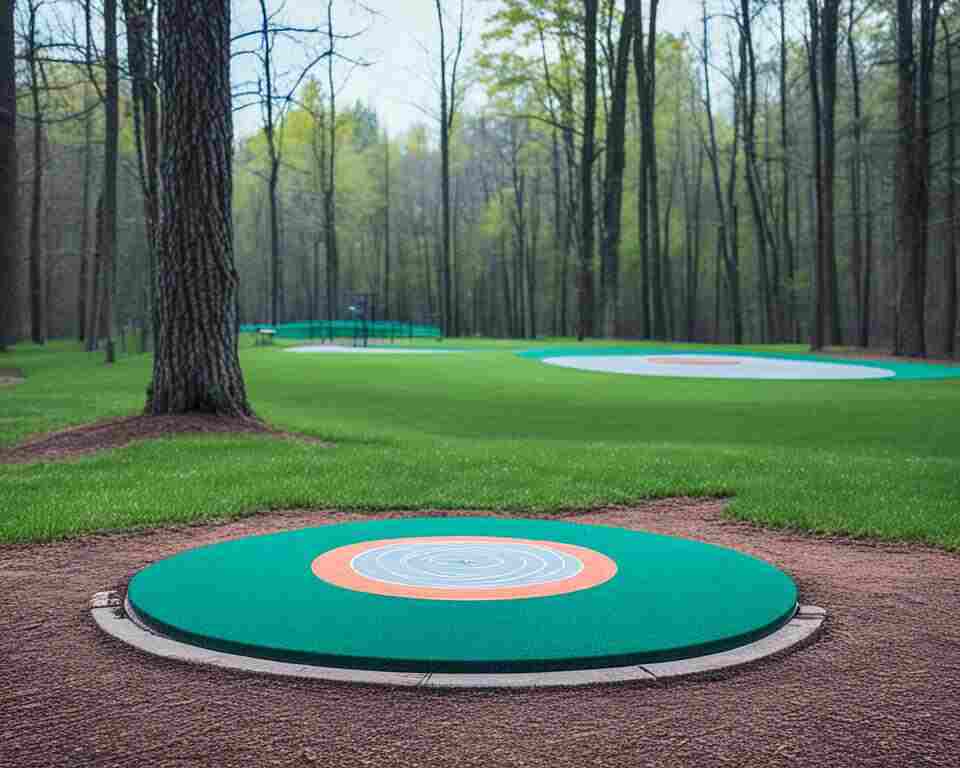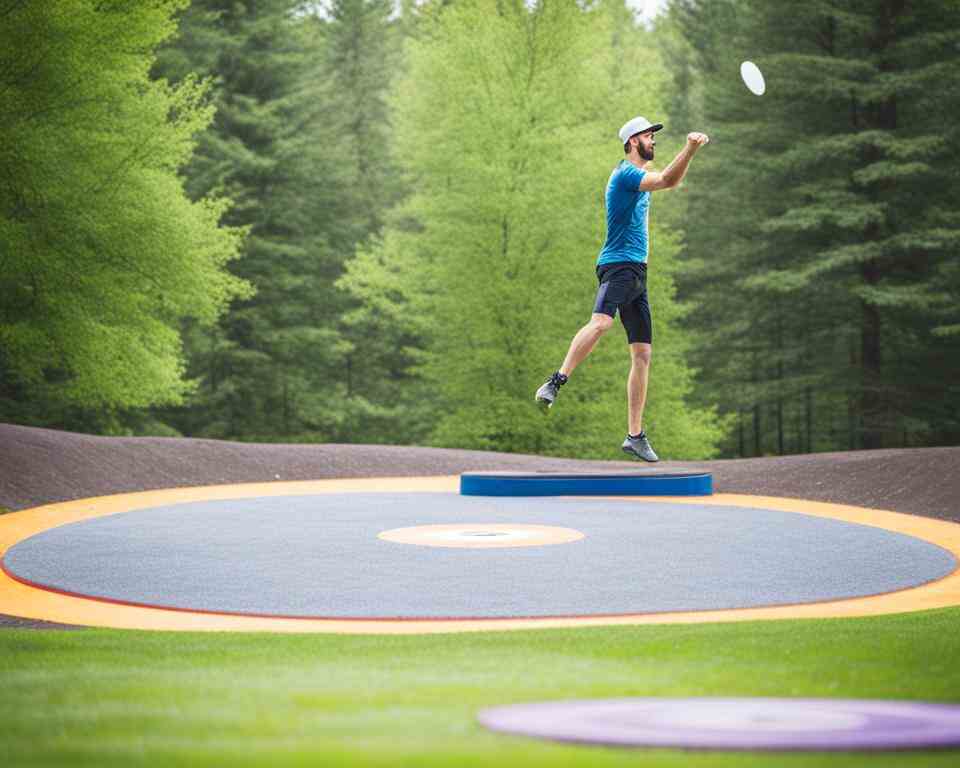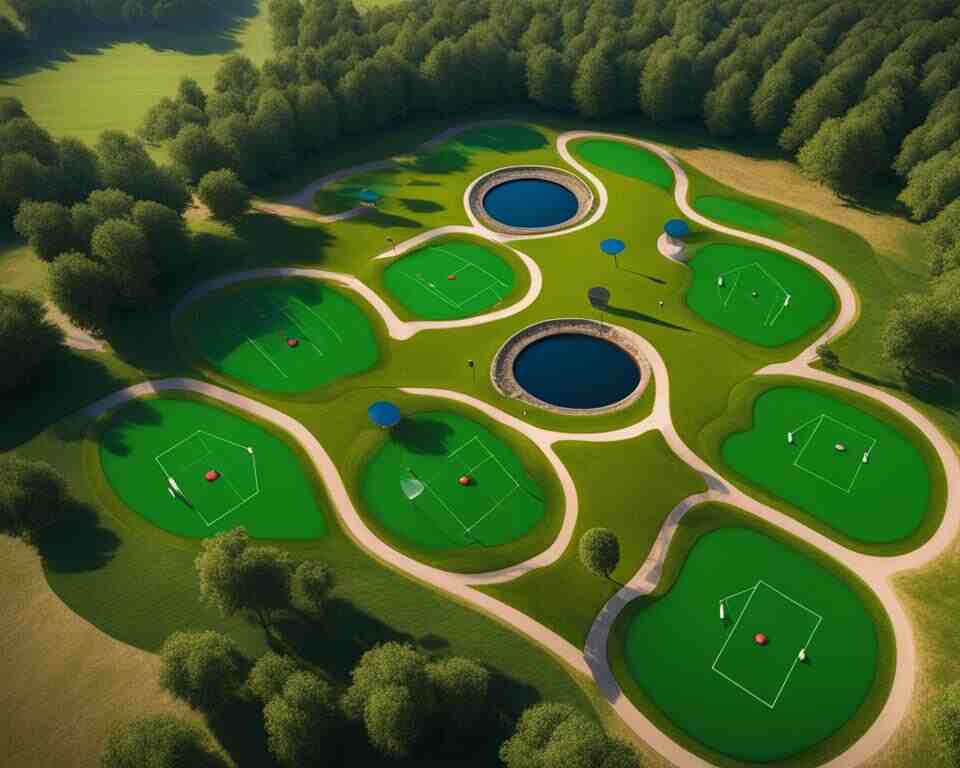Have you ever wondered why some disc golf courses have larger tee pads than others? Is there an ideal size for disc golf tee pads, or is it simply a matter of personal preference?
In this article, I will unravel the mystery behind the optimal disc golf tee pad size and explain why it plays a crucial role in the design and gameplay of a disc golf course.
Key Takeaways:
- Standstill shots in disc golf typically require tee pad sizes ranging from 4 feet wide by 10 feet long to 6 feet wide by 13 feet long.
- For run-up throws, tee pad dimensions should be larger, ranging from 8 feet wide by 12 feet long to 10 feet wide by 20 feet long.
- Tailoring tee pad dimensions to different throwing styles enhances player comfort and performance.
- Understanding ideal tee pad sizes contributes to safer and more enjoyable disc golf experiences.

Understanding the Importance of Tee Pad Design in Disc Golf
Tee pad design is a crucial aspect of creating a high-quality disc golf course. A well-designed tee pad provides a safe and consistent surface for players to execute their throws. It helps prevent injuries, allows for proper footwork and stance, and enhances the overall player experience.
Tee pads also contribute to the aesthetics of a course, creating a professional and polished look. By understanding the importance of tee pad design in disc golf, course designers and enthusiasts can create courses that are enjoyable for players of all skill levels.
How Big is a Disc Golf Tee Pad: Sizing Up Your Options
When designing a disc golf course, one of the key considerations is determining the size of the tee pads. The dimensions of a tee pad play a crucial role in providing players with a stable and level surface to execute their throws. In this section, we will explore the ideal dimensions for different throwing styles, the minimum and maximum size requirements, and the customization options available for tee pad sizes.
Ideal Dimensions for Different Throwing Styles
Disc golf players employ various throwing styles, such as standstill shots or run-up throws, each requiring specific dimensions to accommodate their approach. For standstill shots, a smaller tee pad size may be sufficient, typically ranging from 4 feet wide by 10 feet long to 6 feet wide by 13 feet long.
On the other hand, run-up throws typically require more space, with tee pad dimensions ranging from 8 feet wide by 12 feet long to 10 feet wide by 20 feet long. These larger dimensions allow players to take a few steps or a short run-up before releasing their throw, providing better momentum and distance.
Navigating Between Minimum and Maximum Size Requirements
On the other hand, run-up throws typically require more space, with tee pad dimensions ranging from 8 feet wide by 12 feet long to 10 feet wide by 20 feet long. These larger dimensions allow players to take a few steps or a short run-up before releasing their throw, providing better momentum and distance.
Customizing Tee Pad Sizes for Diverse Course Layouts
One of the advantages of designing a disc golf course is the flexibility to customize tee pad sizes based on the course layout. Designers consider factors such as hole length, obstacles, and player skill levels when determining the dimensions of tee pads. For shorter holes or holes with tight fairways, smaller tee pad sizes may be suitable. Conversely, for longer holes or holes with more open fairways, larger tee pad dimensions provide players with ample space to execute their throws comfortably.
| Throwing Style | Ideal Tee Pad Dimensions |
|---|---|
| Standstill Shots | 4ft W x 10ft L to 6ft W x 13ft L |
| Run-up Throws | 8ft W x 12ft L to 10ft W x 20ft L |
Table: Ideal Tee Pad Dimensions for Different Throwing Styles
By understanding the ideal dimensions for different throwing styles, navigating between minimum and maximum size requirements, and customizing tee pad sizes based on the course layout, designers can create disc golf courses that cater to the needs of players. The right tee pad size not only enhances the player experience but also ensures fair play and safety on the course.

Constructing the Perfect Tee Pad: Materials and Build Quality
When it comes to constructing disc golf tee pads, choosing the right materials and ensuring proper build quality are essential. Tee pads need to be durable, provide optimal playability, and require minimal maintenance. In this section, we will explore the pros and cons of using concrete versus alternative materials, guidelines for leveling and texturing tee pads, and best practices for tee pad installation and maintenance.
Concrete vs. Alternative Materials: Pros and Cons
Concrete is the standard choice for constructing disc golf tee pads. It offers durability, weather resistance, and a long lifespan. Concrete tee pads also provide a consistent surface for players, ensuring fair gameplay. However, there are alternative materials worth considering.
Alternative materials, such as rubber or composite materials, offer some advantages over concrete. They may provide better shock absorption and reduce the risk of injury. Additionally, alternative materials can be more cost-effective and easier to install.
However, alternative materials may have some drawbacks. They might be less durable than concrete and require more frequent maintenance. They may also have a different feel or grip, which can affect player performance. Course designers should carefully evaluate the pros and cons of each material to make an informed decision.
Guidelines for Leveling and Texturing for Optimal Play
Leveling and texturing tee pads are crucial steps in ensuring optimal playability and player safety. Tee pads should be level to prevent tripping hazards and provide a consistent platform for players. Proper texturing helps enhance grip and reduces the risk of slips or falls.
It is recommended to construct tee pads with a slight slope to allow for drainage. This helps prevent water from pooling on the surface, making the tee pads slippery and unsafe. Texturing techniques, such as brooming, can be applied to the surface to improve traction.
Course designers should follow specific guidelines provided by disc golf associations or reputable sources to ensure that tee pads meet the recommended standards for leveling and texturing.
Best Practices in Tee Pad Installation and Maintenance
Installing and maintaining tee pads properly is essential for their longevity and safety. During installation, tee pads should be compacted to provide a stable surface. It is crucial to follow the manufacturer’s instructions or industry best practices to ensure proper installation of both concrete and alternative material tee pads.
Regular maintenance is necessary to keep tee pads in optimal condition. This includes cleaning the surface, removing debris, and repairing any cracks or damage. Additionally, frequent inspections should be conducted to identify and address any safety concerns.
By following the best practices in tee pad installation and ongoing maintenance, course designers and maintainers can ensure that disc golf players have a safe and enjoyable experience on the course.

Conclusion
Disc golf tee pads are an essential element in creating a well-designed and enjoyable disc golf course. By understanding the optimal dimensions for different throwing styles and customizing tee pad sizes for diverse course layouts, we can enhance the overall player experience. Additionally, choosing the right materials and following proper construction and maintenance practices ensure tee pad durability and player safety.
When it comes to tee pad sizing, it’s crucial to consider the specific requirements of players. Different throwing styles, such as standstill shots or run-up throws, demand tee pads with dimensions that accommodate the player’s approach. By providing tee pads that cater to varying throwing styles, we can create a fair and inclusive playing environment for disc golf enthusiasts of all skill levels.
Course designers are also tasked with balancing minimum and maximum size requirements to ensure fair play and safety. Customizing tee pad sizes allows designers to consider factors such as hole length, obstacles, and player skill levels, resulting in a more strategic and challenging course. It’s worth noting that tee pads contribute to the overall aesthetics of a course, creating a professional and polished look that adds to the player’s enjoyment.
In constructing tee pads, choosing the right materials is vital. While concrete is the standard choice due to its durability and low maintenance requirements, alternative materials may offer benefits and advantages in certain situations. Proper leveling and texturing of tee pads play a significant role in providing optimal playability and preventing injuries. By following best practices in installation and maintenance, course designers and maintainers can ensure the longevity and safety of the tee pads, providing a superior disc golf experience for players.


